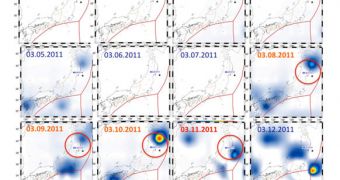Researchers monitoring the Earth's atmosphere propose that it may be possible to determine where and approximately when a massive earthquake will strike. They explain that, before the March 11 tremor that devastated Japan, the air above the epicenter exhibited some peculiar changes.
The team explains that that specific portion of the atmosphere began releasing a lot more infrared radiation than it usually does. The researchers add that this lasted for several days before the earthquake was triggered.
What is interesting about this study is that it provides the first scientific evidence to support public reports indicating the presence of strange atmospheric phenomena in the air before tremors strike.
Understandably, seismologists had a very difficult time confirming these reports until now. However, due to the advent of modern, global-scale monitoring networks, and also the presence of Earth-observing satellites in space, they have now gained this ability.
Before the magnitude 7 earthquake struck Haiti in January 2010, the DEMETER spacecraft for example sent back data indicated increased ultra-low frequency radio signal emissions from the area, Technology Review reports.
In the new observations, which were carried out by experts with the NASA Goddard Space Flight Center (GSFC), in Maryland, it was determined that the Japanese earthquake was also preceded by interesting atmospheric effects.
The team there, led by expert Dimitar Ouzounov, found that the electron content of the ionosphere got boosted the tremendously high levels in the days leading up to the earthquake. Additionally, early results also show that these concentrations reached a peak three days ahead of the natural disaster.
The new data provide additional credence to the theory suggesting the existence of the Lithosphere-Atmosphere-Ionosphere Coupling mechanism. What this theory holds is that the triggering of a major earthquake is preceded by the release of large amounts of radon.
The chemical goes on to ionize the air above the “troubled” area, triggering a cascade of other effects that are conceivably observable if experts know what to look for. One of the most common side-effects is the condensation of water.
This in turn leads to the heating of air above the radon source, and infrared emissions increase as a direct result. “Our first results show that on March 8th a rapid increase of emitted infrared radiation was observed from the satellite data,” Ouzounov explains.

 14 DAY TRIAL //
14 DAY TRIAL //